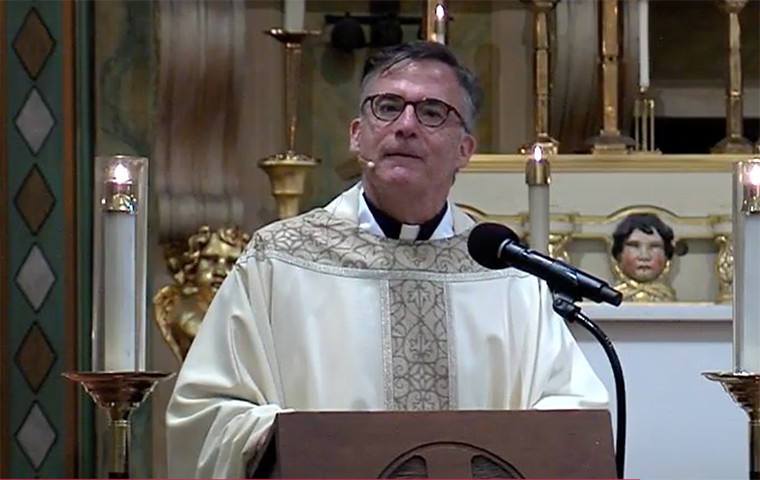
‘When You Pray, Move Your Feet’
Homily for the Feast of St. Ignatius of Loyola
“When you pray, move your feet.”
This African proverb was often repeated by Congressman John Lewis who was buried this week after decades serving our country as a civil rights advocate and public servant.
When you pray, move your feet. And he certainly did. In his Baptist tradition, in which he was ordained as a minister, that surely meant standing and stomping and swaying in Gospel praise. But the proverb meant more than that. His faith moved his feet to act for justice.
He moved his feet as a young man on the freedom ride from DC to New Orleans in 1961, facing violence and imprisonment along the way.
He moved his feet in the March on Washington in 1963.
He moved his feet across that bridge in Selma in 1965, facing police with clubs and angry dogs.
And for over three decades, he moved his feet as he walked about the Capitol, wrangling votes and serving the country.
When you pray, move your feet.
St. Ignatius, whose feast we celebrate today, would have liked that approach to faith in action. In his Autobiography, Ignatius referred to himself as a pilgrim, always on the move. Artistic images present him standing, with walking staff in hand, one foot stepping forward. He was a man on the move, like Jesus was, wandering around Galilee and Palestine. Though the young Ignatius did make it to the Holy Lands, only to get kicked out by the Franciscans, Ignatius’ primary field of play was Europe: Spain and France for studies, and later Italy, where he founded the Jesuits.
Ironically, images of Ignatius later in his life present him seated at a table, writing—certainly another familiar pose for a Jesuit. Administering the Society of Jesus from Rome for the last 16 years of his life, he wrote thousands of letters. Many of those letters were to Jesuits he sent on missions all around Europe and well beyond, to India, Japan, and China. Go anywhere, do anything, that can “help souls,” that can lead people to God, and can serve the common good, he wrote.
This first generation of Jesuits confused people. The Jesuits seemed to be too much on the move. Unlike those in the great monasteries and abbeys of Europe, the Jesuits did not settle in the mountains and hills. They loved the hustle and bustle of cities! They did not stay in one place or town like other priests and nuns. They did not devote themselves to one kind of ministry. They were all over the place – doing all sorts of ministry, including working in schools.
That they opened schools was a great irony. Originally, Ignatius did not want his Jesuits to get involved in schools because he feared the schools would tie them down too much to one place. He imagined the Jesuits as more itinerant. But eight years after founding his religious order, Ignatius opened a school in Sicily and others quickly followed. Why? Because Ignatius realized how much good could be done in and through education to help people and to serve communities.
Facing so many questions about what exactly they were up to, one of the first Jesuits explained, “The world is our house” and “We are contemplatives in action.”
Ignatius put it this way at the end of his Spiritual Exercises: “Love ought to show itself more by deeds than by words.”
When you pray, move your feet.
John Lewis and Ignatius of Loyola were kindred spirits across the ages. Both were imitating Jesus, the one on the move, the one for whom prayer and action were seamless. As it should be for us. The idea of being a contemplative in action is not that we pray at this time or in this place, and act at another time and another place. No, the goal is that our prayer is part of our action, and our action is part of our prayer, so much so that they almost become one. Mind, heart, and feet moving in unison.
This praying and moving of feet, this blending of faith and action, may occur in the ordinary of every day: in our simple prayers or times of quiet and our small acts of kindness and generosity that mark a human life. Our prayers and feet meet also when we engage in larger social movements, like we have seen this summer, in movements for greater racial justice, and our lasting commitment to environmental justice. Faith doing justice.
Knowing Santa Clara much more than I did a year ago, I think that we are really good on the “moving feet” part. For instance, we see our dedicated students serving people in marginalized communities, marching for racial justice, and organizing on our own campus to make Santa Clara a more welcoming place. The greater challenge for us may be the contemplative part. So little time, so much noise. Congressman Lewis and St. Ignatius challenge us today to be people who reflect and not simply react. They challenge us to stretch our spiritual muscles. To develop a habit of interior solitude and to develop our senses to see, listen, feel more deeply. For if we do not couple contemplation and action, we risk our activity becoming diffuse, and thus ineffective, and our energy wasted. Or we risk our justice-making becoming simply ego-building.
When you pray, move your feet. Where? In which direction? For which person or cause? There are many sections of the Lord’s vineyard, many rooms in the Lord’s house, so many people in the beloved community who need our care. So, with the inspiration of St. Ignatius and John Lewis, who has surely joined the communion of saints, let us each discern where our feet will point, making sure—like those images of Ignatius—that we have one foot raised, ready to move.